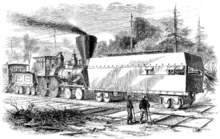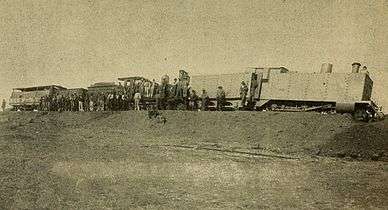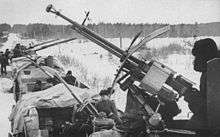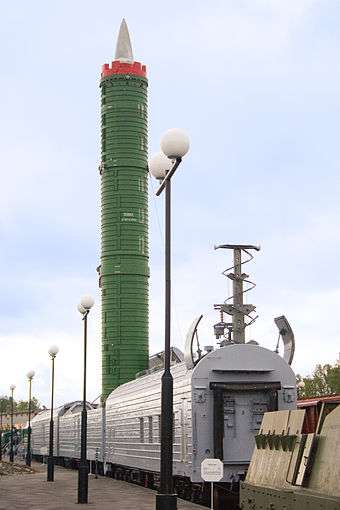Armoured train

An armoured train is a railway train protected with armour. Armoured trains usually include railroad cars armed with artillery and machine guns. They were mostly used during the late 19th and early 20th century, when they offered an innovative way to quickly move large amounts of firepower. Most countries discontinued their use - road vehicles became much more powerful and offered more flexibility, and train tracks proved too vulnerable to sabotage as well as to attacks from the air. However, the Russian Federation used improvised armored trains in the Second Chechen War of 1999-2009.
Design and equipment

The rail cars on an armoured train were designed for many tasks. Typical roles included:
- Artillery - fielding a mixture of guns, machine guns and rocket launchers.
- Infantry - designed to carry infantry units, may also mount machine guns.
- Machine gun - dedicated to machine guns.
- Anti-aircraft - equipped with anti-aircraft weapons.
- Command - similar to infantry wagons, but designed to be a train command centre
- Anti-tank - equipped with anti-tank guns, usually in a tank gun turret
- Platform - unarmoured, used for any purpose from the transport of ammunition or vehicles, through track repair or derailing protection to railroad ploughs for track destruction.
- Troop sleepers
- The German Wehrmacht would sometimes put a Fremdgerät, such as a captured French Somua S-35 or Czech PzKpfw 38(t) light tank, or Panzer II light tank on a flatbed car which could be quickly offloaded by means of a ramp and used away from the range of the main railway line to chase down enemy partisans
- Missile transport - the USSR had railway-based RT-23 Molodets ICBMs by the late 1980s (to reduce the chances of a first strike succeeding in destroying the launchers for a retaliatory strike). The US at one time proposed having a railway-based system for the MX Missile program but this never got past the planning stage
Different types of armour were used to protect from attack by tanks. In addition to various metal plates, concrete and sandbags were used in some cases for improvised armoured trains.
Armoured trains were sometimes escorted by a kind of rail-tank called a draisine. One such example was the 'Littorina' armoured trolley which had a cab in the front and rear, each with a control set so it could be driven down the tracks in either direction. Littorina mounted two dual 7.92mm MG13 machine gun turrets from Panzer I light tanks.
History
Origins


Armoured trains saw use during the 19th century in the American Civil War (1861–1865), the Franco-Prussian War (1870–1871), the First and Second Boer Wars (1880–1881 and 1899–1902). During the Second Boer War, Winston Churchill, then a war-correspondent, was travelling aboard an armoured train on 15 November 1899, when a Boer commando led by General Louis Botha ambushed the train. The Boers captured Churchill and many of the train's contingent, but many others escaped, including wounded soldiers who had been carried on the train's engine.[1]
Early in the 20th century, Russia used armoured trains during the Russo-Japanese War.[2] Armoured trains went on to see use during the Mexican Revolution (1910–1920) and World War I (1914–1918). The most intensive use of armoured trains was during the Russian Civil War (1918–1920). The Spanish Civil War saw a little use of armoured trains, though World War II (1939–1945) saw more. The French used them during the First Indochina War (1946–1954), and a number of countries had armoured trains during the Cold War. The last combat use appears to have been during the Yugoslav wars of the 1990s.
American Civil War
The most successful armored train was a single car built to defend the Philadelphia, Wilmington and Baltimore Railroad. The railroad had been attacked by southern forces to prevent transport of Union soldiers to the front; and snipers were discouraging men attempting to repair the damage. Baldwin Locomotive Works modified a baggage car in late April, 1861. A 24-pounder howitzer was placed on a swivel mount at the opposite end of the car from the pushing locomotive. The sides of the car were sheathed with 2.5-inch (6.4 cm) oak planks covered with 0.5-inch (1.3 cm) boiler plate. The end of the car around the howitzer was fitted with hinged 2-foot (61 cm) panels which could be temporarily lifted to aim and fire the howitzer and then lowered to protect the crew of six men loading the howitzer with grapeshot or canister shot. The remainder of the car contained fifty ports for riflemen. The car was effective for its original purpose, but vulnerability to artillery rendered such cars of comparatively little use during later stages of the war. In August, 1864, a Confederate raiding party disabled a Baltimore and Ohio Railroad locomotive pushing an armored train; and then piled ties around the armored car and set them afire.[3]
World War I
.jpg)

During World War I Russia used a mix of light and heavy armoured trains. The heavy trains mounted 4.2 inch or 6 inch guns, the light trains were equipped with 76.2mm guns.[2]
Austria-Hungary also fielded armoured trains against the Italians in World War I.
A Royal Navy armoured train from Britain, armed with four QF 6 inch naval guns and one QF 4 inch naval gun, was used in support of the British Expeditionary Force in the opening phase of the First Battle of Ypres in October 1914.[4] Two armoured trains were constructed at Crewe during 1915 for coast defense duties; one was based in Norfolk and one in Edinburgh to patrol rail routes on stretches of coast considered vulnerable to amphibious assault.[5]
Interwar years
The Czechoslovak Legion used heavily armed and armoured trains to control large lengths of the Trans-Siberian Railway (and of Russia itself) during the Russian Civil War at the end of World War I.[6]
The Bolshevik forces in the Russian civil war used a wide range of armoured trains.[7] Many were improvised by locals, others were constructed by naval engineers at the Putilov and Izhorskiy factories.[7] As a result, the trains ranged from little more than sandbagged flatbeds to the heavily armed and armoured trains produced by the naval engineers.[7] An attempt to standardise the design from October 1919 only had limited success.[7] By the end of the war the Bolshevik forces had 103 armoured trains of all types.[7]
The Estonians built five armoured trains during the Estonian War of Independence. They were under the command of Johan Pitka.[8]
After the First World War the use of armoured trains declined. They were used in China in the twenties and early thirties during the Chinese Civil War,[9] most notably by the warlord Zhang Zongchang, who employed refugee Russians to man them.
World War II

Poland used armoured trains extensively during the Invasion of Poland. One observer noted that "Poland had only few armoured trains, but their officers and soldiers were fighting well. Again and again they were emerging from a cover in thick forests, disturbing German lines".[10] One under-appreciated aspect of so many Polish armoured trains being deployed during the Polish Defensive War in 1939 is that when German planes attacked the railroads, it was usually the tracks themselves. As late as September 17, three fresh divisions in the east were moved westward by train. On September 18, three more divisions followed.

This in turn prompted Nazi Germany to reintroduce armoured trains into its own armies. Germany then used them to a small degree during World War II. However, they introduced significant designs of a versatile and well-equipped nature, including railcars which housed anti-aircraft gun turrets, or designed to load and unload tanks and railcars which had complete armour protection with a large concealed gun/howitzer. Germany also had fully armoured locomotives which were used on such trains.
During the Slovak National Uprising, the Slovak resistance used three armoured trains. The Hurban, Štefánik and Masaryk, which were built in the Zvolen railway factory, are preserved and can be seen near Zvolen Castle.

The Soviets had a large number of armoured trains at the start of World War II but many were lost in 1941.[11] Trains built later in the war tended to be fitted with T-34 or KV series tank turrets.[11] Others were fitted as specialist anti-aircraft batteries.[11] A few were fitted as heavy artillery batteries often using guns taken from ships.[11]
Canada used an armoured train to patrol the Canadian National Railway along the Skeena River from Prince Rupert, British Columbia to the Pacific coast, against a possible Japanese seaborne raid. The train was equipped with a 75 mm gun, two Bofors 40 mm guns, and could accommodate a full infantry company. The No 1 Armoured Train entered service in June 1942 and was put into reserve in September 1943, to be dismantled in the following year.[12]
Twelve armoured trains were formed in Britain in 1940 as part of the preparations to face a German invasion; these were initially armed with QF 6 pounder 6 cwt Hotchkiss guns and six Bren Guns. They were operated by Royal Engineer crews and manned by Royal Armoured Corps troops. In late 1940 preparations began to hand the trains over to the Polish Army in the West, who operated them until 1942.[13] They continued in use in Scotland and were operated by the Home Guard until the last one was withdrawn in November 1944. A 6-pounder wagon from one of these trains is preserved at the Tank Museum.[14] A miniature armoured train ran on the 15-inch gauge Romney Hythe and Dymchurch Railway.[15]
Later uses

In the First Indochina War, the French Union used the armoured and armed train La Rafale as both a cargo-carrier and a mobile surveillance unit.[16][17] In February 1951 the first Rafale was in service on the Saigon-Nha Trang line, Vietnam[18][19] while from 1947 to May 1952 the second one which was escorted by onboard Cambodian troops of the BSPP (Brigade de Surveillance de Phnom Penh) was used on the Phnom Penh-Battambang line, Cambodia.[20] In 1953 both trains were attacked by the Viet-Minh guerrillas who destroyed or mined stone bridges when passing by.[21] Fulgencio Batista’s army operated an armoured train during the Cuban revolution though it was derailed and destroyed during the Battle of Santa Clara.
Facing the threat of Chinese cross-border raids during the Sino-Soviet split, the USSR developed armoured trains in the early 1970s to protect the Trans-Siberian Railway. According to different accounts, four or five trains were built. Every train included ten main battle tanks, two light amphibious tanks, several AA guns, as well as several armoured personnel carriers, supply vehicles and equipment for railway repairs. They were all mounted on open platforms or in special rail cars. Different parts of the train were protected with 5–20 mm thick armour. These trains were used by the Soviet Army to intimidate nationalist paramilitary units in 1990 during the early stages of the Nagorno-Karabakh War.[22][23]
An improvised armoured train named the "Krajina express" (Krajina ekspres) was used during the war in Croatia (part of the Yugoslav wars) of the early 1990s by the army of the Republic of Serbian Krajina (a self-proclaimed republic of Serbs living within Croatia that sought to remain in Yugoslavia). Composed of three fighting cars and three freight cars hooked to the front to protect it from mine blasts,[24] the train carried a M18 Hellcat with a 76mm cannon, a 40mm Bofors, a 20mm cannon, twin 57mm rocket launchers and a 120mm mortar, plus several machine guns of between 12.7 and 7.62 mm.[25] During the siege of Bihac in 1994, it was attacked on a few occasions with antitank rocket-propelled grenades and 76mm guns and hit by a 9K11 Malyutka missile, but the damage was minor, as most of the train was covered with thick sheets of rubber which caused the missile's warhead to explode too early to do any real damage.[24] The train was eventually destroyed by its own crew lest it fall into enemy hands during Operation Storm, the Croatian offensive which overran the Srpska Krajina. The Army of Republika Srpska operated a similar train that was ambushed and destroyed in October 1992 at the entrance to the town of Gradačac by Bosnian Muslim forces that included a T-55 tank. The wreckage was later converted into a museum.[26] The Croatian Army deployed a two-wagon armoured train built in Split with a shield composed of two plates, one 8mm and the other 6mm thick, with a 30-50mm gap filled with sand between them. The vehicle was armed with 12.7mm machine guns.[27]
Towards the end of the Cold War, both superpowers began to develop railway-based ICBMs mounted on armoured trains; the Soviets deployed the SS-24 missile in 1987, but budget costs and the changing international situation led to the cancellation of the programme, with all remaining railway-based missiles finally being deactivated in 2005.
One armoured train that remains in regular use is that of Kim Il-sung and Kim Jong-il, which the former received as a gift from the Soviet Union and the latter used heavily for state visits to China and Russia as he had a fear of flying.
Pro-Russian militants in the Donbass region of Ukraine were pictured operating a homemade armored train in late 2015.[28]
Armoured tram
Armoured trams also existed, although apparently not purpose-built as some of the armoured trains. The just-formed Red Army used at least one armoured tram during the fighting for Moscow in the October Revolution in 1917.[29][30][31] The Slovak National Uprising, more well known for its armoured trains described above, also used at least one makeshift example.[32]
See also
References
- ↑ Zaloga, Steven J; Bryan, Tony (2008). Armored Trains. Oxford, UK: Osprey Publishing. p. 7. ISBN 978-1-84603-242-4.
- 1 2 Zaloga, Steven J; Grandsen, James (1984). Soviet Tanks and Combat Vehicles of World War Two. Arms and Armour Press. p. 24. ISBN 0-85368-606-8.
- ↑ Dome, Steam (1974). "A Civil War Iron Clad Car". Railroad History. The Railway & Locomotive Historical Society. 130 (Spring 1974): 51–53.
- ↑ 1914: The Days of Hope, Lyn MacDonald, Penguin Books 1989 ISBN 0-14-011651-6
- ↑ Bryan, Tim (2011), Railways in Wartime, Shire Books, ISBN 9780747810506 (p. 21)
- ↑ First World War - Willmott, H.P.; Dorling Kindersley, 2003, Page 251
- 1 2 3 4 5 Zaloga, Steven J; Grandsen, James (1984). Soviet Tanks and Combat Vehicles of World War Two. Arms and Armour Press. pp. 30–33. ISBN 0-85368-606-8.
- ↑ Admiral Johan Pitka (in Estonian language. Accessed 2008-09-11.)
- ↑ "Armored Car Like Oil Tanker Used by Chinese" Popular Mechanics, March 1930
- ↑ Wie das Gesetz es befahl - Karschkes, Helmut, DVG Deutsche Verlagsgesellschaft, ISBN 3-920722-69-8
- 1 2 3 4 Zaloga, Steven J; Grandsen, James (1984). Soviet Tanks and Combat Vehicles of World War Two. Arms and Armour Press. pp. 200–205. ISBN 0-85368-606-8.
- ↑ Rowse, Sue Harper (2005), In Times of War: Prince Rupert 1939-1945 ISBN 978-1411639270 (pp. 82-84)
- ↑ Balfour, G 1981. The Armoured Train: its development and usage. Batsford
- ↑ Railway Wagon 21 Ton Mineral (E1987.159)
- ↑ The Romney Hythe and Dymchurch Railway
- ↑ Le 5e Régiment du Génie d'hier et d'aujourd'hui : l'aventure des Sapeurs de chemins de fer, Lavauzelle, 1997, p. 73 (French)
- ↑ L’audace du rail : les trains blindés du Sud-Annam in Revue historique des armées #234, Alexis Neviaski, 2004, quoted in the French Defense Ministry archives
- ↑ French Defense Ministry archives ECPAD website Archived September 30, 2007, at the Wayback Machine.
- ↑ French Defense Ministry archives ECPAD website Archived September 27, 2007, at the Wayback Machine.
- ↑ French Defense Ministry archives ECPAD website Archived September 27, 2007, at the Wayback Machine.
- ↑ French Defense Ministry archives ECPAD website Archived September 27, 2007, at the Wayback Machine.
- ↑ Sovetskaja Armija v gody "cholodnoj vojny" : (1945–1991) - Fes·kov, Vitalij I; Kalašnikov, Konstantin A; Golikov, Valerij I; Tomsk Izdat. Tomskogo University. 2004, Page 246- ISBN 5-7511-1819-7
- ↑ Last armored trains of the Soviet Army Archived May 30, 2008, at the Wayback Machine. (in Cyrillic/Russian language) - Markovian, Victor; Мир оружия, 9/2005
- 1 2 "Krajina Express" enhances Serb Firepower near Bihac Deseret News, 4 December 1994
- ↑ Radic, Aleksandar (2008). Историја - Крајина експрес. Aрсенал magazine, nº 14, pp. 51-54. Minister of Defence of Serbia, 15 February 2008 (Serbian)
- ↑ Photo and comments from Panoramio
- ↑ Hrvatski oklopni voz (Serbian)
- ↑ http://tvzvezda.ru/news/vstrane_i_mire/content/201512281518-dey6.htm
- ↑ First World War - Willmott, H.P.; Dorling Kindersley, 2003, Page 231.
- ↑ Московские трамваи в боях за Советскую власть (Russian)
- ↑ Мы мирные люди, но наш бронепоезд стоит на трамвайном пути! (Russian)
- ↑ The Czech and Slovak Republics (excerpt from Google Books) - Humphreys, Rob, Rough Guide, 2002, ISBN 1-85828-904-1, Page 482
Further reading
- Zaloga, Steven J; Bryan, Tony (2008). Armored Trains. Oxford, UK: Osprey Publishing. ISBN 978-1-84603-242-4.
External links
| Wikimedia Commons has media related to Armoured trains. |
- Finnish armoured trains
- Soviet armoured trains
- Russian armoured trains
- Website on the Polish armoured trains
- The armored trains that turned the Civil War
